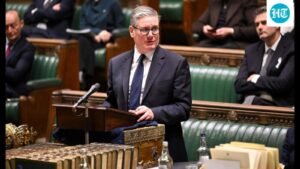
The Strategic Mutual Defense Agreement Signed Between Saudi Arabia and Pakistan on September 17, 2025, Marks A Significant Turning Point in West In West Asian Geopolitics, Formalising a Decades-Long Stratangic Alignment and Creating new ripples that could be alter regional security Architectures and Challenge India’s Strategic Positioning. This unprecedented pact establishs a Nato-Style Mutual Defense Commitment, Declaring that “Any Agrassion Against Either Country Country Country Shall be Considered An Against Both”. While Building Upon Nearly Eight Decades of Deep-Seated Bilateral Cooperation, this provision legally obligates Mutual support in the event of an attack, an attack, enhanstry posons, ENANCADESS, ENHANCED Intelligence sharing, and coordinated deterrence strategies, buttressed by saudi investments of up to $ 15 billion in Pakistan’s defense-industrial complex.

While not explicitly stated, the Ambigious “Comprehensive Defensecive” Scope of the agreement has fuled interpretations of an implicit nuclear dimension. Theory posits that Pakistan’s Arsenal, Estimated at 170 Warheads, Could Indirectly Expend a Nuclear Deterrent to Saudi Interests with Physical Transfers. This arrangement would Navigate Non-Preliferation Norms and Avoid Direct Violations of Us Non-Proliferation Laws, Leverapping Pakistan’s Status as a Non-Signature to the Nuclear Nuclear Nuclear ( Its rejection of a no-friendly-use policy. However, this nuclear umbrella theory is constased. Sceptics argue the pact is more a political signal of solidarity than an unconditional war guarantee, noting that pakistan’s nuclear doctrine doctrine remains overWhelming Structures are unlikely to be subordinated to foreign interests.
The agreement’s timing reflects a calculated saudi response to the perceived breakdown of the us-licked security order in the region. Israel’s unprectednted trans-border air strikes on doha, a gcc member and close us ally, crossed a signal red line, excursing fundamental vulnerabilitys in the amaryrican seconds. This has prompted gulf states, LED by Saudi Arabia, to adopt a Hedging strategy aimed at diversifying security partnerships in an increasing multipolar world. The subsequent calls for an Arab-Islamic Nato, A Concept Building On the Existing 43-Meember Islamic MILITARY COUNTARY COUNTER TERRORISM Coalition (ImC Confirming that the “doors are not closed” for other nations to join the pact.
For India, this defense pact presents multifaceted challenges. First, It Deepens The China-Pakistan Strategic Nexus, Potentially Created a Coordinated Axis That Cold Challenge Indian Interests. Chinese Diplomatic and Intelligence support could enhance Pakistan’s Regional Influence, What Economic Partnerships With Gulf States Might Provide Alternative Financing for Pakistani MILITARY Capability, Complicating India’s Strategic Balancing Act. Initiatives Like the India-Middle East-Economic Corridor (IMEC), which passes through saudi arabia, now face an additional layer of political Uncertainty. While The Project Alarady Confronts Significant Financing and Logistical Hurdles, Riyadh’s Binding Defense Commitments to Islamabad Cold COMPLICATE FUTUTUTE FUTUTUTE FUTUTUTE FUTUTUTE FUTUTUTE FUTUTURE FUTUTETE FUTUTURE COPLICATE Initiative.
Second, the agreement may dilute international pressure on Pakistan through forums like the financial action task force (fatf). Although Pakistan was removed from the fatf’s green list in 2022, its elevated role as a key security provider in west asia group Grant It GRANT Iter Diplomatic Leverage. While Saudi Arabia’s Influence Within The Consensus-Based Fatf is Not Absolute, It Blad Make it More Challenging to Build A Cualition to Hold Pakistan Accountable For Terror Fun Terror Funning in the Fun. This, in turn, may embolden Pakistan-based non-staters like lashkar-e-taiba and jaish-e-mohammed, potentially lowering the threshold for cross-border provocations and complicing indian’Sia Response Calculus.
However, Several Moderating Factors Temper The Most Alarmist Scenarios. India’s carefully groved strategic partnership with Saudi Arabia, A Leading Energy Supplier and Significant Investor, is unlikely to be discarded. Riyadh has been quick to ressure new Delhi of its commission to bilateral ties in counterrorism, maritime security, and energy. More Importantly, the Kingdom’s overriding priority is the success of its Vision 2030, An Ambitious Plan for Economic Diversification and Social Reform that Regional Stability and A Society Investigation Climate. BECCECT A Co-BelligeRant in an India-Pakistan Confluent Delhi Directly Threten these core objectives, making riyadh more likely to act as a Crisis manager or MediaTor Than An activipant.
Confronted with these new realities, India’s Response must be multited, combining diplomatic, economy, and security efforts under the umbrella of strategic autonomy. India should intensify its engine with gulf partners by expanding cooperation in defense, countersorism, and meritime security, While Simultaneous Bolsteering Economic Ties. India’s Strengths in Digital Public Infrastructure, AI, and Green Energy Solutions Align Perfectly with Gulf Diversification Goals, Offering a Superir Value Proposition. India Can Enhance Cooperation through forums like i2U2 (India, Israel, UAE, US) to foster regional integration projects. Critically, India must actively Pursue Alternative Connectivity Routes, Such as the International North-South Transport Corridor (Instc) and the Chabahar Port, Which Bypass Pakistani, to Mitigate Potentan Disruptions to IMEC and enhance its Regional Influence, While Acknowledging The Geopolitical Challenges these projects face.
Ultimately, while the saudi-pakistan definition agreement Reflects Broader Geopolitical Shifts Rather THAN A Fundamental Anti-India Align, The Optimal Path Forward Forward for India is not one of confron of Confronte Alarmism. India should adopt an approach of strategic patience, complemented by enhanced defense -preparedness and a proactive diplomatic and economic ageda. The most effective response is asymmetrical: to level India’s unique and formidable strengths in technology, trade, and human capital, thereby being an indispansable partner in the gulf ‘ Economic Transformation. By demonstrating a superior and more comprehensive value proposation, India can ensure that its partnerships in the region are not only resilient but thrive to Thrive.
In navigating the complexities of a Multipolar West Asia, India’s Greatest Asset will be its ability to prove that it is the region’s most valuable partner for the future.
Ausaf says is a former ambassador of India to saudi arabia and yemen. The views expressed are personal




